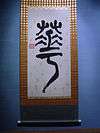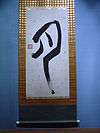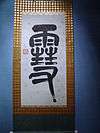Tokugawa Nariaki
| Tokugawa Nariaki | |
|---|---|
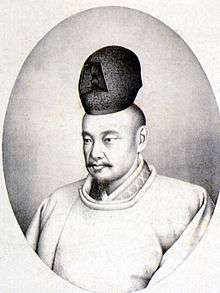 Tokugawa Nariaki | |
| 9th Lord of Mito | |
|
In office 1829–1844 | |
| Preceded by | Tokugawa Narinobu |
| Succeeded by | Tokugawa Yoshiatsu |
| Personal details | |
| Born | April 4, 1800 |
| Died | September 29, 1860 (aged 60) |
| Nationality | Japanese |
Tokugawa Nariaki (徳川 斉昭, April 4, 1800 – September 29, 1860) was a prominent Japanese daimyo who ruled the Mito domain (now Ibaraki prefecture) and contributed to the rise of nationalism and the Meiji restoration.
Biography
Clan leader
Nariaki was the 3rd son of Tokugawa Harutoshi, the seventh generation daimyo of Mito. The family headship first passed to Harutoshi's eldest son Narinobu, before being passed on to Nariaki in 1829.[1] Nariaki was also leader of the Jōi (expel the barbarian) party and made a Bakufu adviser on national defence.[2]
Bakufu official
Nariaki was put in charge of Bakufu efforts to defend the country against encroaching foreigners. His own view was that the bakufu should strengthen its military and fight the foreigners, and was at odds with Ii Naosuke on the issue. He was pro-emperor and favored imperial restoration. Nariaki also greatly expanded the Mitogaku school established by Tokugawa Mitsukuni. He wrote a document entitled "Japan, Reject the Westerners" in 1853. in this document, he stated ten reasons why Japan should stay isolated from the rest of the world. He said that the Japanese people had a choice between war and peace, but clearly to him, the Japanese people should choose war so that Westerners would not intrude into Japan's affairs.
Nariaki and Naosuke fought over who would succeed the Shogun Iesada, with Nariaki championing his son Yoshinobu. Naosuke, who eventually prevailed, favored the Wakayama Domain daimyo Tokugawa Yoshitomi.
Legacy
In 1841, Nariaki built Kairaku-en, a garden whose fame lasts to this day.
Nariaki retired in 1844 in favor of his son Yoshiatsu, and died of a heart attack in 1860, at age 60.
Three of the leading figures of the 1860s were in fact natural brothers, all being sons of Nariaki: Hitoshubashi Yoshinobu, who became the 15th and last shogun as Tokugawa Yoshinobu in 1866; Tokugawa Yoshiatsu of Mito; and Ikeda Yoshinori of Inaba (Tottori).[3]
Works
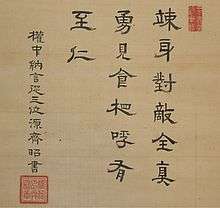
Published posthumously:
- Kōdōkan ki 弘道館記 (1937). Ed. by Meiji Seitoku Kinen Gakkai 明治聖德記念學會. Tokyo: Meiji Seitoku Kinen Gakkai 明治聖德記念學會.
- Meikun ippanshō 明君一斑抄 (1910–1911). Ed. by Kurokawa Mamichi 黒川真道. Tokyo: Dōbunkan 同文館.
Notes
See also
| Wikimedia Commons has media related to Tokugawa Nariaki. |
References
- Beasley, William G. (1955). Select Documents on Japanese Foreign Policy, 1853-1868. London: Oxford University Press. [reprinted by RoutledgeCurzon, London, 2001. ISBN 978-0-19-713508-2 (cloth)]
This article incorporates text from OpenHistory.
Further reading
- Kobayashi Kenji 小林健二 (1998). Tokugawa Nariaki to hansharo 徳川斉昭と反射炉. Tokyo: Sōei Shuppan 創栄出版.
- Lambeti, Matthew V. (1968). A political study of Tokugawa Nariaki of Mito, 1800-1860. New York: Columbia University. (microfilm)
- Ōniwa Kunihiko 大庭邦彦 (1997). Chichi yori Yoshinobu dono e: Mito Nariaki Hitotsubashi Yoshinobu ate shokanshū 父より慶喜殿へ: 水戶斉昭一橋慶喜宛書簡集. Tokyo: Shūeisha 集英社.
External links
| Royal titles | ||
|---|---|---|
| Preceded by Tokugawa Narinobu |
Daimyo of Mito 1829-1844 |
Succeeded by Tokugawa Yoshiatsu |
